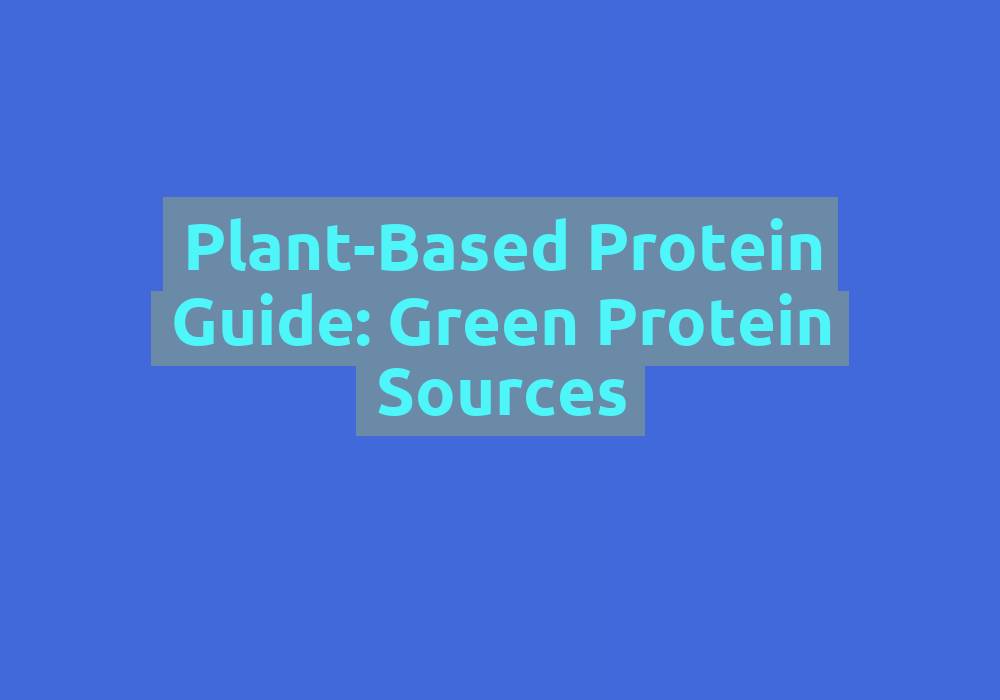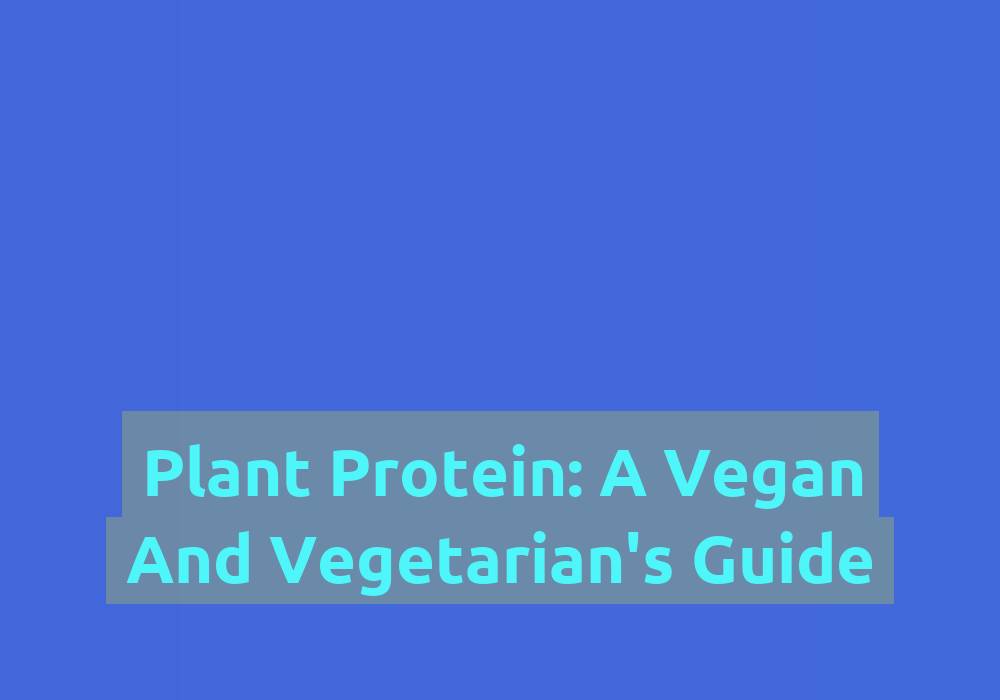Plant-Based Protein Guide: Green Protein Sources

Protein is an essential nutrient that plays a crucial role in our overall health and well-being. Many people believe that obtaining sufficient protein can only be achieved through animal-based sources. However, there is a growing trend towards plant-based diets, and various green protein sources are available to meet our nutritional needs. In this guide, we will explore some excellent plant-based protein sources that can be incorporated into a balanced diet.
Legumes
Legumes are a versatile and affordable source of plant-based protein. They include various types of beans, lentils, and chickpeas. Legumes are not only high in protein but also rich in fibers, complex carbohydrates, vitamins, and minerals. They offer a great alternative to those who follow a vegetarian or vegan diet. Let’s take a closer look at some popular legumes:
- Black beans: With around 15 grams of protein per cup, black beans are a fantastic source of plant-based protein. They are also loaded with fibers, iron, and folate. Black beans can be used in a variety of recipes such as soups, stews, and salads. They can even be mashed and formed into burgers or used as a filling for tacos.
- Lentils: Lentils are protein powerhouses, providing approximately 18 grams of protein per cup. They are low in fat and high in fiber, making them a highly nutritious and filling addition to meals. Lentils come in different varieties, such as green, brown, and red, each with its own unique taste and texture. They can be used in soups, curries, salads, and even as a meat substitute in dishes like lentil loaf or lentil burgers.
- Chickpeas: Not only are chickpeas a great source of protein, with approximately 15 grams per cup, but they are also packed with vitamins and minerals. They can be used to make delicious hummus, added to salads, or roasted for a healthy snack. Chickpeas can also be mashed and formed into patties for homemade veggie burgers or used as a base for grain-free pizza crusts.
Incorporating legumes into your diet not only helps meet your protein needs but also provides a good dose of dietary fibers, which can aid in digestion and promote feelings of fullness. Additionally, legumes are an excellent source of complex carbohydrates, which provide sustained energy and support overall health.
Green Leafy Vegetables
When it comes to green protein sources, leafy greens are often overlooked. However, many leafy vegetables contain a surprising amount of protein while being low in calories. Incorporating these greens into your diet is a fantastic way to increase your protein intake while reaping the benefits of their abundant vitamins and minerals. Let’s explore some examples:
- Spinach: Spinach is not only rich in iron and vitamins, but it also contains nearly 3 grams of protein per cup. It can be easily added to smoothies, salads, or cooked dishes to enhance their nutritional value. Spinach is also a great source of antioxidants, which help protect the body against oxidative stress and inflammation.
- Kale: Known for its incredible nutrient profile, kale offers approximately 3 grams of protein per cup. Additionally, it is an excellent source of vitamins A, C, and K, as well as calcium and antioxidants. Kale can be enjoyed raw in salads, sautéed as a side dish, or blended into smoothies for a nutritious boost.
- Broccoli: This cruciferous vegetable contains about 2.6 grams of protein per cup. It is also packed with fiber, vitamins C and K, and various antioxidants, making it a highly nutritious green protein source. Broccoli can be steamed, roasted, or added to stir-fries and soups to add a crunchy texture and added protein to your meals.
Leafy greens not only provide protein but are also rich in essential nutrients like vitamins, minerals, and antioxidants. Adding them to your meals not only boosts your protein intake but also supports overall health and well-being.
Nuts and Seeds
Nuts and seeds are not only delicious and versatile but also provide a good amount of plant-based protein. They are also rich in healthy fats, vitamins, minerals, and dietary fibers. Let’s take a closer look at some examples of nuts and seeds that can boost your protein intake:
- Almonds: Almonds are a rich source of protein, providing approximately 6 grams per ounce. They are also high in vitamin E, magnesium, and healthy fats. Enjoy them as a snack, in salads, or as a delicious nut butter. Almonds can also be used in baking to add a protein-rich twist to your favorite recipes.
- Chia seeds: Chia seeds are a tiny superfood, packed with protein, healthy fats, and fiber. With around 4 grams of protein per ounce, they can be added to smoothies, yogurt, or used as an egg substitute in baking recipes. Chia seeds also absorb liquid and form a gel-like consistency, making them a great addition to puddings and overnight oats.
- Hemp seeds: Hemp seeds are a complete protein source, containing all nine essential amino acids. They offer approximately 10 grams of protein per ounce and are also rich in omega-3 fatty acids. Sprinkle them on salads, incorporate them into energy bars, or blend them into smoothies for an added protein boost. Hemp seeds have a mild, nutty flavor that pairs well with both sweet and savory dishes.
Incorporating nuts and seeds into your diet not only provides a protein boost but also delivers essential nutrients that support heart health, brain function, and overall well-being. They can be enjoyed as a standalone snack, added to meals, or used as ingredients in various recipes.
Plant-Based Protein Powders
For those seeking a convenient and concentrated source of plant-based protein, protein powders can be a great option. They are typically made from legumes, grains, or seeds and can easily be added to smoothies, shakes, or baked goods. Here are a few popular options:
- Pea protein: Derived from yellow peas, pea protein is an excellent choice for those with allergies or sensitivities to other protein sources. It is highly digestible and provides around 20 grams of protein per serving. Pea protein powder can be mixed with water or plant-based milk to create a quick and easy protein shake, or added to recipes like pancakes or muffins for an extra protein boost.
- Brown rice protein: Brown rice protein is hypoallergenic and suitable for those following a gluten-free diet. It contains all essential amino acids and offers approximately 24 grams of protein per serving. Brown rice protein powder can be blended into smoothies, stirred into oatmeal, or used in baking recipes to increase the protein content while adding a subtle nutty flavor.
- Soy protein: Soy protein is a complete protein source that provides all essential amino acids. It is also rich in iron, calcium, and other minerals. Soy protein powder typically contains around 20 grams of protein per serving. It can be incorporated into post-workout shakes, used as a base for protein bars, or added to pancake batter for a protein-packed breakfast.
Protein powders offer a convenient way to increase your protein intake, especially for those with busy lifestyles or specific dietary needs. They can be easily customized to suit your taste preferences and can be enjoyed as part of a well-balanced diet.
Conclusion
Incorporating plant-based protein sources into your diet can offer numerous health benefits while reducing your environmental footprint. The examples provided above are just a glimpse into the wide variety of green protein sources available. By including legumes, leafy greens, nuts, seeds, and plant-based protein powders in your meals, you can easily meet your protein requirements while enjoying a diverse and nourishing diet. Remember to consult with a healthcare professional or registered dietitian to ensure that your dietary choices align with your specific nutritional needs.
FAQ
1. What are some popular legumes that are high in protein?
- Black beans, lentils, and chickpeas are popular legumes that are high in protein.
2. How much protein do leafy greens contain?
- Leafy greens such as spinach, kale, and broccoli contain approximately 2-3 grams of protein per cup.
3. Which nuts and seeds are rich in plant-based protein?
- Almonds, chia seeds, and hemp seeds are nuts and seeds that are rich in plant-based protein.
4. What are some plant-based protein powders?
- Pea protein, brown rice protein, and soy protein are popular plant-based protein powders.

